Revised 5 March 2022
Accepted 24 October 2022
Available Online 21 November 2022
- DOI
- https://doi.org/10.55060/s.atssh.221107.007
- Keywords
- Official script
Evolution
Zhangcao
Regular script - Abstract
There are various forms of Chinese calligraphy styles and the evolution of Chinese font is a long and tortuous process. As a font style that serves as a link between past and future, official script is of great significance in the evolution of Chinese calligraphic font, which can be divided into ancient official script and Han official script. After a long and continuous process of simplification, the ancient official script became more and more mature in the widespread use of Western Han and Eastern Han Dynasties. In the period of Emperor Huan and Emperor Ling of the Eastern Han Dynasty, its practicality and artistry reached an unprecedented height. In the short decades from Qin to Han, the change of calligraphy style was rapid. While the official script gradually matured, it also gave birth to other calligraphy styles, mainly cursive script and regular script. In the history of Chinese calligraphy, the achievements of official script have two peaks, one is the period during Han Dynasty and the other is Qing Dynasty. The official script of Qing Dynasty has become a pure art form of calligraphy, which not only inherits the tradition, but also has the characteristics of the times with strong artistic vitality.
- Copyright
- © 2022 The Authors. Published by Athena International Publishing B.V.
- Open Access
- This is an open access article distributed under the CC BY-NC 4.0 license (https://creativecommons.org/licenses/by-nc/4.0/).
1. INTRODUCTION
The development of Chinese fonts from seal script to official script has undergone significant changes in the font structure, and since then it has laid the foundation for the font structure of modern Chinese characters. It is an important turning point in the history of the evolution of Chinese characters, a great leap in the change of the font structure, and an important process of the evolution of calligraphy styles. This process not only includes the development law of calligraphy art, but also shows the social background, geographical environment and mentality of calligraphers and other factors in the development of calligraphy art. From the life course of official script, people have seen the development of the whole calligraphy art, which is a history of continuous innovation and development.
2. PRODUCTION OF OFFICIAL SCRIPT
2.1. Origin of the Name of Official Script
The official script can be divided into ancient official script and Han official script. The “ancient official script” is a folk writing style of the Qin and Six Kingdoms in the Warring States Period, and it is actually a scribbled way of writing the small seal script. After Qin unified the Six Kingdoms, the government issued an order of “Towards One Chinese Characters”. The large seal script, which had been used for a long time in the Zhou Dynasty, was sorted out by Li Si and others and became a standardized and stereotyped new script, which was historically called the small seal script, namely, the parent script of official script to evolve later. Due to the unification and fixation of the objects of official script change, the development goals of the folk official script tended to be unified, and the official script was on the road to maturity since then.
Regarding the origin of the name “official script”, according to Zhang Huaiguan's Shu Duan (书断) in the Tang Dynasty, Cheng Miao was the creator of official script. Legend has it that Cheng Miao was good at writing large seal script. He was originally a small official in a prison and was imprisoned because he offended the First Emperor of Qin. After ten years of research in prison, he increased or decreased the strokes of small seal script characters to form 3,000 official script characters, which was appreciated by the First Emperor of Qin, who then released him and gave him an official position. Because the script he created was convenient for officials to use, it was called official script.
In some literature, some scholars also refer to official script as “Fenshu” (分书) or “Bafen” (八分). There are several statements about the origin of the name “Bafen”, which can be roughly classified into three types. The first statement is that Wang Cizhong of the Qin Dynasty believed that the strokes of ancient fonts were lacking ups and downs, so the official script font was used as the orthodox, and the font was 八分 (“分” was the ancient unit of length) square, so there was an orthodox font, believing that this statement originates from the scale of words. The second argument is that the official script gradually evolved into a shape like the Chinese character “八”, so it was called “八分” script. The third statement is the one recorded in Ye Tinggui's Hailu Suishi · Literature · Epistle (海录碎事·文学·书札) in the Northern Song Dynasty, namely, “As for 八分, Cai Wenji said: ‘My father took two 二分 from the 八分 in the official script, and 八分 from the 二分 in the seal script, so the official script was called 八分”. Wu Qiuyan of Yuan Dynasty believed that as for the font of “八分”, Han official script had no ups and downs, it was easier to identify than Qin official script, and more like seal script than later official script. If the official script was written in the style of writing seal script, the ancient “八分” font would be obtained [1]. The third statement is based on Cai Wenji's words, and its writing style doesn't refer to the typical Han official script with Botiao. Here, it won't be further detailed. The first statement takes its name from the size. The Han ruler is 23.5 centimeters today, and the font is 八分, about 2 centimeters square. If it is written on bamboo slips, the font is too large, but it's also too small compared to the existing Han stele font. There is no other example of naming a calligraphy style by size, therefore, it remains unconvincing. Only the second statement seems plausible and is accepted by most people. Most of the inscriptions in the Later Han Dynasty belong to the Bafen official script.
There is also a statement that the Han Mo Zhi (翰墨志) written by Gaozong Zhao Gou of the Southern Song Dynasty divided the calligraphy styles into five types: regular script, running script, cursive script, seal script, and official script, and the Fenshu was called official script. In the feudal society, the emperor's opinion had absolute authority, so after the Southern Song Dynasty, most people renamed the Fenshu as the official script [2].
2.2. Early Official Script
In fact, it is a long and continuous process of simplification from the emergence to the development of any new calligraphy styles, and those regular and fixed calligraphy styles are the result of the official arrangement. Cheng Miao, as a master of official script, made many pioneering efforts in the process from seal script to official script, and was the first calligrapher to popularize the use of official script. Therefore, it is reasonable for Zhang Huaiguan to call him “the ancestor of official script”. However, the official script in Qin Dynasty was not a formal font, and small seal script was generally used in more solemn occasions, such as the inscription stones erected in Mount Tai, Langya Mountain, Guijishan Mountain and other places during the first emperor's eastern tour. The existing ones include “Taishan Carved Stones” (Fig. 1) and “Langyongtai Carved Stones”, which are the standard small seal script that are said to be written by Li Si. The organization is well-proportioned and neat, the brushwork is lean and rounded, and the lines are periphrastic in their ebullience, with the beauty of dignity and elegance. At that time, official script had been widely used in the documents made by officials of the Qin Dynasty, and this fact was confirmed in Yun Meng Qin Jian (云梦秦简) unearthed from the Qin tomb.
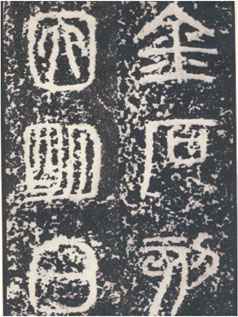
“Taishan Carved Stones”.
“Yun Meng Qin Jian” is the general term for a large number of bamboo slips unearthed in 1975 from Tomb No. 11 in Shuihudi, Yunmeng County, Hubei Province. The owner of the tomb was an official at that time, so more than half of the slips recorded actual legal provisions and official texts at that time, such as the Chronicle, which recorded the main events of the Qin State in the first year of King Zhao of Qin (306 BC) since the era of the First Emperor of Qin.
In the early official script, silk books played an equally important role. Taking the silk books unearthed from the Mawangdui Han Dynasty Tomb in Changsha as an example, the Mawangdui Han Dynasty Tomb was the joint tomb of Li Cang, the prime minister of Changsha, who was later enfeoffed with the land of Dai, and his wife. The unearthed silk book Lao Zi has two versions: version A and version B. Version A is the first to be discovered in the documents attached to the Lao Zi. The full text of it consists of 464 lines and more than 13,000 characters. The font is between seal script and official script, and some scholars call it “cursive script”. Version B (Fig. 2) has 152 lines and more than 16,000 characters, which is the authentic official script. There is a volume of records of the activities of the lobbyist Su Qin during the Warring States Period in the silk book. Since this silk book didn't have a title, based on the fact that Su Qin was called a “Political Strategist” in Hundred Schools of Thought (诸子百家), the academic circles named it Letters Home by Political Strategists in the Warring States Period (战国纵横家书). Compared with version A of Lao Zi, the book was closer to the official script. In addition, there is a volume of divination book Astronomical Meteorological Mixed Divination (天文气象杂占), with a total of 350 pieces, each of which is painted in ink or vermilion with celestial phenomena such as clouds and stars, and their names, explanations and inscriptions are noted below. Its calligraphy style is the same as that of the version A of Lao Zi, which is between seal script and official script, belonging to the transitional calligraphy that evolves from small seal script to official script. Since the name of Liu Bang, the Emperor Gaozu of Han Dynasty, appears in the version A of Lao Zi and Astronomical Meteorological Mixed Divination, according to China's unique habits (such as avoiding the emperor's name, using pronouns or omitting the words, etc.), it can be speculated that the above-mentioned silk books may have been written before Gaozu claims to be an emperor. Although the version B of Lao Zi and Letters Home by Political Strategists in the Warring States Period avoids the word “bang (邦)”, the names “Ying (盈)” and “Heng (恒)” of Emperor Hui (刘盈) and Emperor Wen (刘恒) are used as usual, so it is estimated that they are hand-copied books during the reign of Gaozu. The former calligraphy style is between small seal script and official script, and the latter is a more mature official script, which also proves that their written time is indeed different [3].
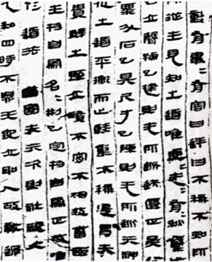
“Lao Zi”, version B.
3. GLORIOUS ERA OF OFFICIAL SCRIPT
The official script became more and more mature in the widespread use of Western Han and Eastern Han Dynasties, and after a long and continuous process of simplification, it became more tidy and regular, and there were left-falling strokes and right-falling strokes, i.e., starting one word with a horizontal stroke, which first raises and then lowers, and then raises to make a corner angle with a wavy state, and left-falling strokes and right-falling strokes run in the opposite direction. With the development of Chinese characters to official script, the pictographic flavor gradually diminished, the structure became more and more simplified, and the forms of stippling gradually enriched. The development of simplicity and complexity made Chinese calligraphy art begin to focus on expressing font structure with free and diverse line changes and spaces, expressing the author's thoughts and feelings, thus bidding farewell to the primitive era of “calligraphy and painting in one”, sublimating to highly abstract lines artistic realm, and marking the maturity of Chinese calligraphy as an independent art form.
In the early Western Han Dynasty, although various documents and unearthed cultural relics proved the appearance of paper, bamboo slips still existed as a common writing material in the following hundreds of years. The length of bamboo slips was strictly regulated in the hierarchical society of the Han Dynasty. For example, the imperial edict was 1 chi and 1 cun long, the policy book of conferring titles of nobility on feudatory kings was 2 chi long, and the classic length was 2 chi and 4 cun. Lun Heng · Xie Duan (论衡 谢短篇) says: “2 chi and 4 cun, said by the sage” [4]. The length of The Book of Songs, Book of History, Book of Rites, Book of Changes, etc. are all 2 chi and 4 cun. Ordinary records and books of scholars are 1 chi.
The unearthed Han bamboo slips are mainly concentrated in the northwest areas and inland provinces. In order to deal with the invasion and harassment of the Xiongnu, Emperor Wu of the Han had fortified in the northwest areas such as Dunhuang and Juyan, and left a large number of letters and official documents on bamboo slips. In these documents, the character pattern was completely horizontal, each character was flat and wide, and the left-falling strokes and right-falling strokes were also fuller than other strokes. Although there were different styles due to different writers, the full expansion of left-falling strokes and right-falling strokes showed the beauty of softness and smoothness of the motion changes in the brush strokes, such as No. 1524A and No. 1524B Juyan Han bamboo slips and bamboo slips of the fourth year of Heping (25 BC), etc. In 1973, the official script of Han bamboo slips in the middle and late Western Han Dynasty unearthed in the Han tomb at No. 40 Bajiaolang, Dingxian County, Hebei Province, reversely started and flatly ended. The first strokes of main strokes were all dignified, which were finished lightly and fast, with rich and full left-falling strokes and right-falling strokes, wide and flat structures, stable centers of gravity and soothing forms, being fully equipped with the beauty of mature official script and very similar to the Yiying Stele (乙瑛碑) in the middle and late Eastern Han Dynasty that had gotten rid of the calligraphic style of seal script. Unearthed in 1959, the wooden slips of Etiquette (礼仪) from the Han Tomb No. 6 Mojuzi, Wuwei, Gansu Province, were about the works of Emperor Chengdi of the Western Han Dynasty (32 BC-7 BC), which were transcriptions of Confucian classics, with free and easy strokes, sometimes being finished with exposed cusps, and there were hook strokes and left-falling strokes that were similar to later regular script. These changes have important implications for studying the evolution of calligraphy styles [3].
Most of the bamboo slips unearthed in the northwest region were from the Xin Dynasty and early Eastern Han Dynasty, and most of them inherited the calligraphy style in the late Western Han Dynasty. The number of bamboo slips in the late Eastern Han Dynasty was very small. The wooden slips from the first year to the second year of Yanxi (158-159 AD) of Emperor Huan of the Eastern Han Dynasty unearthed in Gansu had a large extension of the main strokes and a compact center structure, which were vigorous and unrestrained without being hasty.
There was also an important form of calligraphy in the Western Han Dynasty, namely, the engraved calligraphy, including bronzes, seals, carved stones, and eave tiles. Such works often had the factor of official script, some of the official script had slightly curved strokes, and the organization was smooth and beautiful. Among the Chinese inscriptions and engraved stones, there were also vivid and simple ones, such as: Huai Wang Yu Xi (淮王玉玺), Engraved Stone in the Second Year of Wufeng (五凤二年刻石) (Fig. 3), etc. In the Western Han Dynasty, because there was no stone inscription called “stele” in terms of shape and structure and function as in the Eastern Han Dynasty, the stone with words seen was called “engraved stone”. There were very few engraved stones in the Western Han Dynasty, the shape and structure were not fixed, the qualities of stones were rough, but the calligraphy style was forceful, sincere, dignified, simple and straightforward.
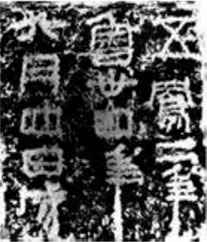
“Engraved Stone in the Second Year of Wufeng”.
In the late Eastern Han Dynasty, on one hand, during the Emperor He of Han period, paper was widely used as a writing material, and the rich expressive power and high sense of freedom unique to the ink brush were expressed wildly. The stippling lines of different forms using brush enhanced the formal beauty of the official script. On the other hand, the rulers of the Eastern Han Dynasty advocated reputation and integrity, filial piety and Confucianism. Scholar-bureaucrats were keen on fame and prestige, and after they died, they would get an elaborate funeral and monuments would be set up to eulogize their merits and virtues. Under this circumstance, the art of inscriptions on steles, epitaphs, stone classics, inscriptions on precipices etc. prevailed on a large scale, the official script also got the best opportunity for development, and there was an unprecedented brilliant prosperity of it, which became the main content of inscription art in the Han Dynasty.
The exquisiteness of Han steles reached a peak during the reign of Emperor Huan and Emperor Ling in the Eastern Han Dynasty. During this period, the official script was full of beauty, diverse in style, exquisite in stroke pattern, full of pitching changes and the beauty of left-falling strokes and right-falling strokes. It developed into a unique style of calligraphy style that was completely different from the seal script, representing the artistic achievements and styles of the Eastern Han Dynasty official script. Most of the inscriptions are concentrated in Shandong, Henan, Sichuan and Shaanxi. For example, in Xiyue Huashan Mountain Temple Stele (Fig. 4) and Stele of Cao Quan (曹全碑) (Fig. 5) unearthed in Shaanxi, the former's calligraphy style is set to order, dignified and rigorous, with elegant and gorgeous bearing, while the latter is graceful and fine, stretching and free. They are the representative works of Chinese beauty and the beauty of fineness and powerfulness of Han steles respectively. There is also Ode to Shimen (石门颂) whose calligraphy style is thin, hard, unrestrained, vigorous and soft, which is known as the cursive script in official script, full of artlessness. Yang Shoujing said in Comment on Steles (评碑记): “His brush is like the solitary cloud and the wild crane, with ethereal lightness. Excellent and outstanding people of Six Dynasties appear from it” [1]. Unearthed in Qufu, Shandong Province, the calligraphy style of Stele of Ritual Vessels (礼器碑) is thin and powerful, vigorous, and fine and graceful, which belongs to the fine and powerful school of Han steles. In addition, the Stele of Zhang Qian (张迁碑) unearthed in Dongping County, Shandong Province has a simple and elegant calligraphy style, with changeable upright and foursquare and neat features, which is a typical example of being upright and foursquare in Han steles. Sichuan Province is a province with many inscriptions and a clear regional calligraphy style. Generally, there are two types, one is the upright and foursquare ones like Stele of Fan Min (樊敏碑) and the other is the indulgent and unrestricted ones such as Shen Fu Jun Que Ming (沈府君阙铭). Especially in the latter, the horizontal strokes are stretched to the fullest, open in a bizarre way, without hanging and no hindrance, being very unique, which are quite similar to the official script of Han bamboo slips in the middle and late Eastern Han Dynasty unearthed in Gansu. A large number of Huangchang stone inscriptions unearthed in Luoyang, Henan Province and some portrait inscriptions, epitaphs, cliff tomb inscriptions and other sketching engraved stone characters in the Eastern Han Dynasty, are small in length or handwriting. Most of them are buried in not little-known places, the engraving is more casual, the strokes are mostly flat and straight without ups and downs or Botiao, and the structure is also direct and unrestrained, looking simple and high-spirited. These engraved stones account for eight or nine out of ten of the Eastern Han inscriptions, and are important materials for the study of Han official script writing techniques and calligraphy history.
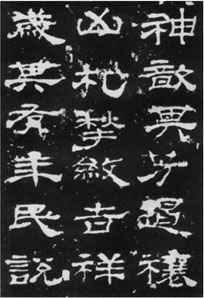
“Xiyue Huashan Mountain Temple Stele”.
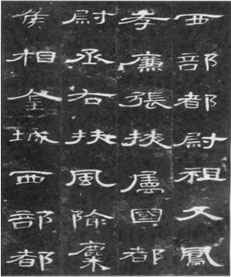
“Stele of Cao Quan”.
The richness of Eastern Han inscriptions is a great feat in Chinese history. During the fourteen years of Emperor Huan and Emperor Ling (146-189 AD), there were more than 700 types of Eastern Han inscriptions recorded, and more than 170 types of books of rubbings were handed down, and there are 60 types of Han steles in existence. Wang Shu of the Qing Dynasty said in the Preface and Postscript of an Empty Boat (虚舟题跋) that, “The official script reached a peak in the Han Dynasty. Each stele had its own uniqueness. There were no two steles that were the same. Each Han stele has a style, which can be described as colorful and varied. Each Han stele is also a calligrapher's fine work, with exquisite and wonderful wording, which is extremely precious” [5].
4. EVOLUTION OF THE OFFICIAL SCRIPT'S CALLIGRAPHY STYLE
4.1. Transformation From Official Script to Cursive Script
In the short decades from Qin to Han, the change of calligraphy style was rapid. While the official script gradually matured, another calligraphy style, cursive script, came into being. When the cursive script was born in the Qin and Han dynasties, Cai Yong once said: “In the early Qin Dynasty, the princes fought for a long time, and the official documents were delivered through the courier station. Due to the difficulty of writing in seal script and official script, they couldn't be used in an emergency, so a quick writing style was used, which is today's cursive script. It can be seen that the cursive script originally evolved from the official script. At that time, the official script was simplified in writing and served as “the script for emergency”, so there was the cursive script. Xu Shen's Shuo Wen Jie Zi Xu (说文解字 叙) said: “The cursive script rose in the Han Dynasty”. The handwritten cursive script in the early Han Dynasty was cursive official script, and later gradually developed into Zhangcao. Zhangcao (a specific kind of cursive hand of Chinese calligraphy) mostly adopted the posture of official script, but was written in concise and hasty brushwork, retaining the stroke trail of official script. Although some of its strokes were joined together in an encompassed manner and some structural components were omitted, each character was written independently in one stroke. Especially for a bamboo slip with multiple lines, each character was bound by the characters on its left and right sides. The start of horizontal strokes should not be too long and the strokes had to be restrained inwards to connect the strokes below, giving a vertical sense of force, which could be said to be a unique calligraphy style in the Han Dynasty. There are different opinions on the origin of the name of Zhangcao and most agree that it was named after the founding of Emperor Zhang of the Han Dynasty. In the Tang Dynasty, Cai Xizong said in On Model Calligraphy (法书论) that “Zhangcao appeared in the period of Emperor Zhang of the Han Dynasty”. In Tang Dynasty, Wei Xu's Compilation of Fifty-six Calligraphy Styles (纂五十六种书) said: “The font of Zhangcao was created by Du Duo in the Eastern Han Dynasty. Because Emperor Zhang of Han Dynasty liked it, it was named ‘Zhangcao’”. In the Tang Dynasty, Zhang Yanyuan said in Calligraphy Works Catalogue (法书要录): “Zhangcao was originally used during the reign of Emperor Zhang of the Han Dynasty” (Fig. 6).
During the Eastern Han Dynasty, the number of bamboo scripts in cursive script increased significantly, and the fonts became more mature. The brushwork was bold and unrestrained and the stroke pattern was open and unconstrained (such as Shi Jian Guo Di Huang Si Nian Jian, 始建国地皇四年简, 23 BC). By the Jin Dynasty, the cursive script in the works of wooden slips and remnant paper completely got rid of the influence of the Fenshu, the strokes were linked together, the brush strokes were free and flexible, as if they were written without stopping, and the characteristics of regular script appeared. For this kind of change, in order to distinguish in terms of the name, later generations referred the cursive script with the characteristics of Fenshu, which emphasized horizontal trend with left-falling strokes and right-falling strokes and incoherence, as Zhangcao, and called the up-down coherent cursive script with the characteristics of regular script emphasizing vertical trend without left-falling strokes and right-falling strokes Jincao (今草) [3].
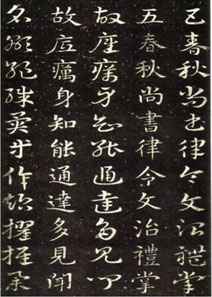
Hurriedly-written essay of Zhangcao.
There was an important figure in this transformation process – Zhang Zhi, the “cursive-sage” in the era of Emperor Huan and Emperor Ling of the Eastern Han Dynasty. Zhang Zhi was good at cursive script, surpassing Du Du and Cui Yuan based on learning their cursive script. The body structure of his cursive script was connected with the imposing style, the qi channels were connected, and there was little factor of official script, like floating clouds and flowing water, being inextricably tangled together. Zhang Zhi's reformation of Zhangcao made it take a decisive step. The representative calligrapher in the mature stage of cursive script was Wang Xizhi, who was known as the “sage of calligraphy” in the Jin Dynasty. His representative work Shi Qi Tie (十七帖) (Fig. 7) was fresh and meaningful and had great influence on later generations. In the Tang Dynasty, Zhang Xu and Huai Su created Kuangcao (狂草, an excessively free cursive style), emphasizing vertical and horizontal coherence without stopping, improving the expressive freehand ability of cursive script to a new height. Progressing from cursive script to Kuangcao, the cursive script gradually lost its use value of recording language, and only the value of artistic appreciation remained.
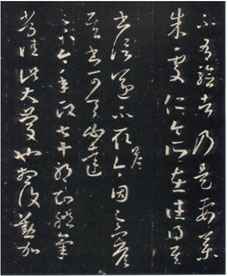
Wang Xizhi’s “Shi Qi Tie”.
4.2. Transformation From Official Script to Regular Script
Regular script, also known as “Zhenshu (真书)”, “Zhengshu (正书)”, and “Jinli (今隶)”, is a calligraphy type evolved from the differentiation of official script. It changed the Han official script font's “twists and turns”, “first strokes' being dignified while last strokes' being light and fast”, as well as being square and flat, and replaced it with straight strokes and square structure, becoming a mature stroke character. “楷” means “model”, and regular script (楷书) is a model calligraphy that can be used as a model.
Zhang Huaiguan in the Tang Dynasty said in the Volume “Bafen” in Shu Duan: “It was originally called regular script. The regular script refers to rules, styles, and templates. Confucius said that it is passed down from present to future generations and becomes a model. Therefore, any type of calligraphy style that has the functions of model and laws can be called regular script”. Regarding the origin of regular script, there is a legend that Wang Zhongci created regular script in Qin Dynasty, and some people think it was Zhong Yao, a great calligrapher during the Three Kingdoms period, that created it. These just show that the regular script is not created by only one person, but it is a conscious evolution of the calligraphy style in the process of use. However, it should be admitted that Zhong Yao has indeed made a great contribution to the process of transformation from official script to regular script. The gorgeous emblazonry techniques of official script enrich the artistic expression of Chinese characters, but at the same time, because the handwriting cannot be coherent, it affects the fluency of writing, which is contrary to the utility function of Chinese characters as language recording symbols. The stippling of official script cannot take into account the requirements of both artistry and practicality, so it is not a perfect font and must be further developed to solve the problem of continuity of the strokes of the upper and lower stippling on the original basis. In general, after the horizontal stroke stops, the starting stroke of the next stroke is at the lower left of it, so it cannot be jutted out to the upper right and must be pressed down and paused and finished to the left. If the left-falling stroke is to be coherent with the following strokes, the closing stroke cannot be pressed down and paused and must be jutted out in accordance with the situation, which then will present a tapering appearance. To be coherent with the following strokes, the horizontal strokes and vertical strokes should sometimes derive hook strokes and rising strokes. All these needs for coherence have led to the variation of official script stippling, leading to the emergence and development of regular script.
In the early days of regular script, although the stippling has been hooked and risen risen and the stroke pattern and the method of regular script have become quite obvious, the strokes still have a strong official script style. The Wu Shi Shu Volume II (吴十书 卷二) discovered in Xinjiang in 1924 is a typical calligraphy style of this period. Its brush strokes are soft and the character patterns are square, but at the same time, there are left-falling strokes and right-falling strokes of official script, showing the transition tendency from official script to regular script. Zhu Fo Yao Ji Jing (诸佛要集经) (found in Xinjiang in 1908, is the earliest known manuscript of Buddhist scriptures in the world), which is a little later than Wu Shi Shu Volume II, was written during the Yuankang period of the Western Jin Dynasty. The font is rigorous, square and neat, and it is basically close to regular script. In the Eastern Jin Dynasty, Wang Xizhi's regular script developed greatly. He followed Mrs. Wei's suit, was influenced by the calligraphy of “cursive-sage” Zhang Zhi, and gained the spiritual strength and momentum of Zhong Yao's calligraphy, forming his unique style of being unrestrained, elegant, magnificent and powerful. The Le Yi Lun (乐毅论) and Huang Ting Jing (黄庭经) (Fig. 8) have been passed down to later generations. Wang Xianzhi changed his father's style and made his own one. And his regular script Luo Shen Fu Shi San Hang (洛神赋十三行) is handed down. Later in the same period, in the north, the Tuoba clan of Xianbei established the Wei Dynasty, which was called the Northern Wei Dynasty in history. The calligraphy of the Northern Wei Dynasty is most famous for the inscriptions, known as “Wei stele” in history, which is a unique aesthetic model in the history of Chinese calligraphy. “Wei stele” is mostly mature regular script, and there are four types of inscriptions on steles, inscriptions on precipices, inscriptions for the Buddhistic sculptures and epitaphs. The overall style and features are rough and simple, and the aptitude is free, raunchy and has its own temperament, which is completely different from the literati calligraphy style of the Wei and Jin dynasties that is reserved, unrestrained, solemn and honest and sincere. This has an inevitable connection with the historical and cultural background of the northern turmoil at that time. The calligraphy of the inscription in the Northern Wei Dynasty follows no set form, has no sect or school, mostly from the hands of stonemason, and has the charm of folk calligraphy style. The most representative ones are Twenty Pins of Dragon Gate (龙门二十品) [6], etc. (Fig. 9).
Literati calligraphy has been in the mainstream since the end of the Han Dynasty. Wei stele was not valued by people before the Qing Dynasty, and the development track of regular script continued all the way with the calligraphy of “two-Wangs”. Since the Tang Dynasty, the calligraphy of regular script has completely eliminated the official script brushwork often carried in the Southern and Northern Dynasties. To begin with, there were the “Four Brilliant Calligraphers in Early Tang Dynasty” who inherited two-Wangs' calligraphy style — Ouyang Xun, Yu Shinan, Chu Suiliang and Xue Ji; later, there were Yan Zhenqing and Liu Gongquan, creating a style of their own, and were later called “Muscle of Yan Style and Bone of Liu Style”, becoming the creators of the new style of regular script. In the early stage, the stippling of Ouyang Xun's regular script was firm and forceful with slender stroke pattern; in the mid-term, Yan Zhenqing's style was opposite to Ouyang Xun's, with vigorous stippling and broad stroke pattern; in the later period, Liu Gongquan integrated Ouyang Xun and Yan Zhenqing's style characteristics, adopted an eclectic expression technique, and wrote majestic and straight. The works of the three calligraphers reflect the three periods of development of regular script calligraphy in the Tang Dynasty. The style and form of regular script has been fully expressed in the Tang Dynasty, like a blooming flower, showing its most brilliant moment. Regular script's stippling forms and stroke patterns are rich and varied, and all strokes are very coherent in writing, being both pleasing to the eye and convenient, integrating artistry and practicability. After 1,500 years, it is still the most widely used calligraphy style today.
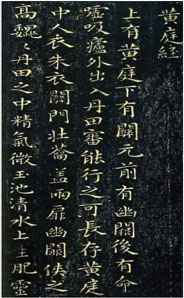
“Huang Ting Jing”.
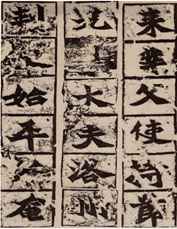
“Shi Ping Gong Zao Xiang Ji”.
5. CONCLUSION
In the 3000-year history of Chinese calligraphy, the official script only took more than 400 years from budding to maturity, but this process does contain various factors and laws of the evolution of calligraphy styles, becoming a topic of never-ending inquiry. It is like a crossroad in the history of calligraphy, giving people unlimited and unobstructed possibilities. It was once told that learning Han steles may not necessarily make you a calligrapher, but calligraphers must learn Han steles. Calligrapher Wang Dongling, a student of the contemporary cursive-sage Lin Sanzhi, said: “My teacher's cursive script is based on the foundation of Han stele skills of fifty or sixty years”. It can be seen that the official script plays an important role in the learning of calligraphy. Theory should always serve practice. Only by understanding the formation and evolution of official script can people better learn and carry forward the spirit of Chinese calligraphy art. This is what people should pursue unremittingly.
REFERENCES
Cite This Article

TY - CONF AU - Shaoduan Zhang PY - 2022 DA - 2022/11/21 TI - The Origin and Evolution of Official Script in Chinese Calligraphic Font BT - Proceedings of the 8th International Conference on Arts, Design and Contemporary Education (ICADCE 2022) PB - Athena Publishing SP - 31 EP - 39 SN - 2949-8937 UR - https://doi.org/10.55060/s.atssh.221107.007 DO - https://doi.org/10.55060/s.atssh.221107.007 ID - Zhang2022 ER -









